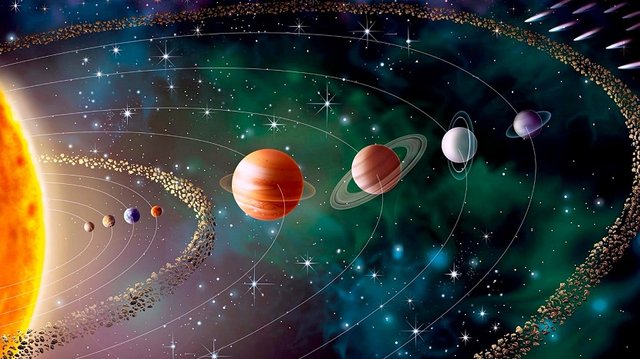Our Planet Family: Mercury #1
Hello Steemians!
This is a saga that I've been preparing and I hope you like it!.

Have you ever been thinking about the planets? Have not you thought about how wonderful and mysterious a planet can be? Or the universe itself? For a while I've been "collecting" information about them and today I come to talk about:

What do we know about this little planet? Next I'll give you a brief description:
Mercury, the planet closest to the Sun, moves slowly on its axis, but it circles the Sun rapidly. Little was known about its surface until the Mariner 10 planetary probe was sent and observations were made with radar and radio telescopes.

As we already know Mercury is the planet closest to the Sun, it is bigger than Pluton and smaller than the other planets. He was named as the Roman god of speed and commerce by the way he quickly appears in the morning or night sky for a few days and then stays out of our sight.

The day is twice as long as a year.
Duration of the day: 176 Earth days.
Duration of the year: 88 Earth days.
It takes Mercury 59 days of Earth to make a complete rotation.
Mercury's first telescope observations date back to Galileo in the 17th century.
In 1965 it was found that the rotation period was definitely 59 days.
Temperatures: - 279 degrees Fahrenheit on the side away from the sun; 801 degrees Fahrenheit on the side facing the sun
Diameter: 4.879.4 km
Average distance from the Sun: 57,909,175 km
Doesn't have moons
Composition: rocky (mainly iron)
Because Mercury is very close to the Sun and has no atmosphere, the temperature varies greatly between the side facing the Sun and the side away from it. In the illuminated part, temperatures can reach hundreds of degrees, hot enough to melt tin and lead. In the dark part, the temperature drops to more than one hundred degrees below zero. It is a planet of extremes.
Mercury rotates slowly, but has a fast orbit speed, about 50 kilometers per second! Its year is 88 Earth days. But it takes 59 Earth days to turn around on its axis. As Mercury completes three rotations for every two orbits around the Sun, a whole day (the time it takes for the Sun to return to the same point in the sky) is about 176 Earth days. So your day turns out to be twice as long as your year. Mercury is truly a rare lane!
Mercury has a very elliptical orbit, so it approaches up to 47 million kilometers from the Sun and moves up to 70 million kilometers from it. Its surface is marked by thousands of craters as a result of the impacts of many objects during the primitive age of the solar system.

Mariner 10
The Mariner 10 probe (1974-1975), or Mariner X, was the first ship to study the planet Mercury in depth. I had also visited Venus, using the gravitational trajectory assistance of Venus to accelerate towards the planet. He made three overflights of Mercury; the first at a distance of 703 km from the planet, the second at 48,069 km, and the third at 327 km. Mariner took a total of ten thousand images of much of the planet's surface. The mission ended on March 24, 1975 when it ran out of fuel and could not maintain orientation control.

Fuente
MESSENGER
MErcury Surface, Space ENvironment, GEochemistry and Ranging (Surface of Mercury, Space Environment, Geochemistry and Extension) was a probe launched in August 2004 to put into orbit around Mercury in March 2011. It was expected that this ship would significantly increase knowledge scientist on this planet. For this, the ship had to orbit Mercury and make three overflights - on January 14, 2008, October 6, 2008, and September 29, 2009. The mission was scheduled to last one year. The orbital insertion of the probe was successfully carried out on March 18, 2011. Finally, the end of this successful mission occurred on April 30, 2015, when the probe fell on the surface of the planet, producing a controlled impact.

Fuente
great info
thanks :)